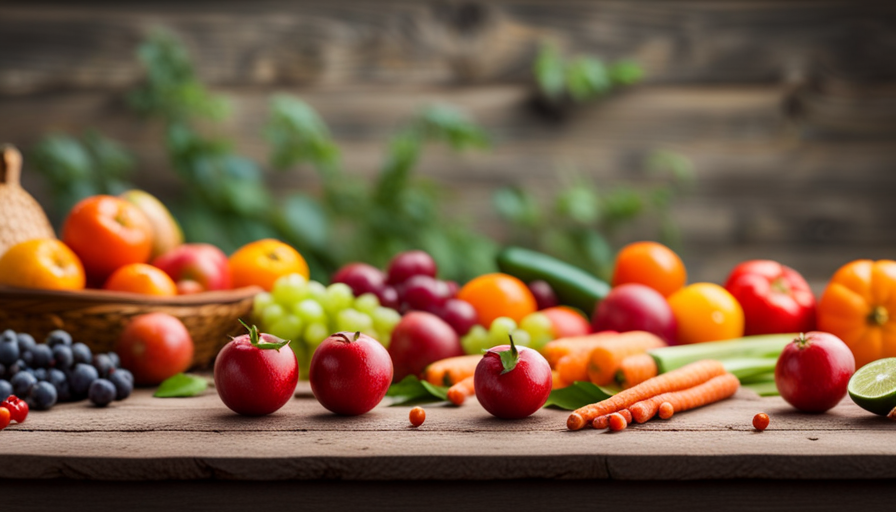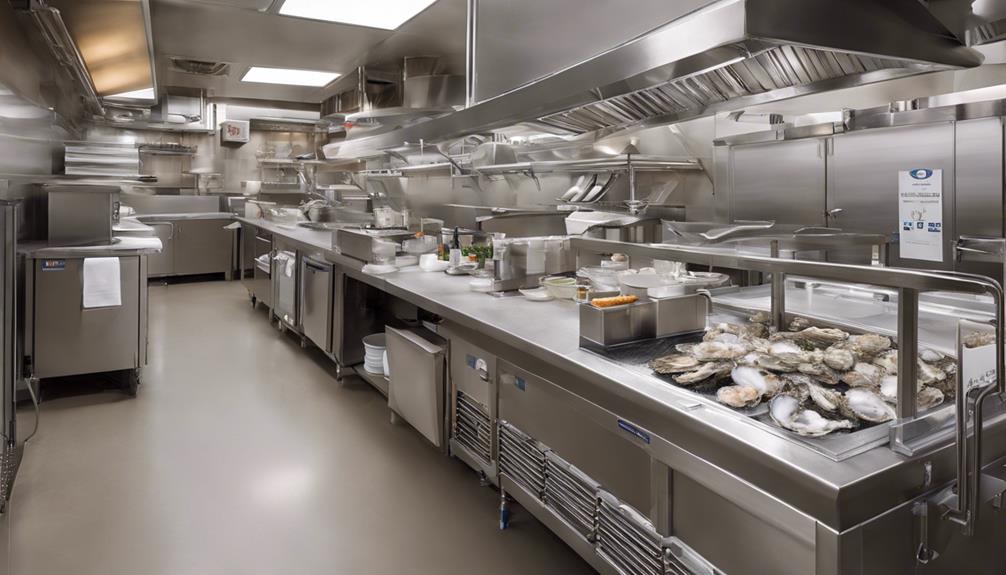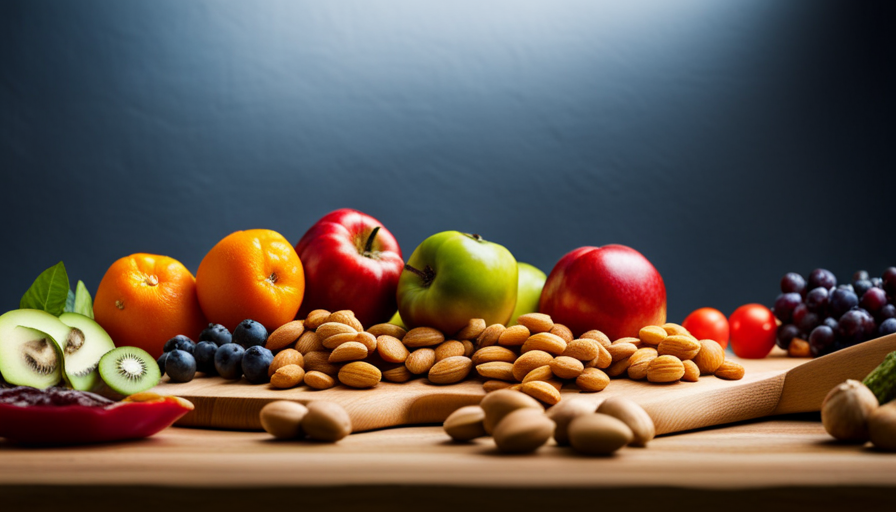Are you someone who follows a “raw food diet”? You’re not alone! There is a growing community of raw food enthusiasts who believe in consuming uncooked, unprocessed, and plant-based foods.
This dietary approach, known as the Raw Food Diet, has gained popularity due to its numerous health benefits and the belief that raw foods retain more nutrients and enzymes than their cooked counterparts.
By opting for a raw food lifestyle, you are making a conscious choice to prioritize your health and well-being.
In this article, we will delve into the world of raw food nutrition, exploring the science behind it, and providing you with practical tips to incorporate raw foods into your daily routine.
Additionally, we will share delicious raw food recipes, advice on shopping for and storing raw ingredients, and discuss the long-term effects and sustainability of this lifestyle.
Get ready to discover the incredible potential of raw food and embark on a journey towards optimal health!
Key Takeaways
- The raw food diet emphasizes the consumption of uncooked, unprocessed, and plant-based foods.
- Raw foods retain more nutrients, enzymes, and antioxidants compared to cooked foods.
- Incorporating raw foods into the diet can lead to weight loss, improved digestion, and overall well-being.
- Meal planning with raw ingredients, choosing organic and locally sourced options, and joining a raw food community can help overcome challenges and maximize the benefits of a raw food lifestyle.
Understanding the Raw Food Diet
If you’re curious about the raw food diet, you’re in for a treat! The raw food diet is all about consuming uncooked and unprocessed foods. This diet is gaining popularity due to its potential health benefits.
One of the main attractions of the raw food diet is the abundance of raw food recipes available. From delicious salads and smoothies to creative raw desserts, you’ll never run out of options.
The raw food diet has its fair share of pros and cons. On the positive side, raw foods are packed with nutrients and enzymes that can boost your overall health. Additionally, this diet is low in calories and high in fiber, which can aid in weight loss and digestion. Raw food enthusiasts also claim increased energy levels and improved skin complexion.
However, there are some drawbacks to consider. The raw food diet can be challenging to follow, as it requires careful meal planning and preparation. It may also be deficient in certain nutrients, such as vitamin B12 and iron. Furthermore, some people may find it difficult to meet their protein requirements solely through raw foods.
The raw food diet offers a wide range of delicious recipes and potential health benefits. However, it’s important to weigh the pros and cons before deciding if it’s the right dietary choice for you.
Exploring the Benefits of Eating Raw
Indulging in the natural goodness of fresh, uncooked ingredients can truly revolutionize your well-being and leave you feeling invigorated from the inside out. When comparing raw food to cooked food, it’s important to consider the nutritional benefits. Raw foods retain more nutrients because they are not exposed to high heat, which can destroy certain vitamins and enzymes. Cooking can also cause the loss of water-soluble nutrients like vitamin C and B vitamins. By opting for a raw food diet, you can ensure that you are getting the maximum nutritional value from your food.
But the benefits of eating raw go beyond just nutrients. Raw foods are often lower in calories and higher in fiber, making them an excellent choice for weight loss. The high fiber content can help you feel fuller for longer, reducing the likelihood of overeating. Additionally, raw food is typically free from processed sugars and unhealthy fats, making it a healthier option overall.
To better understand the benefits of eating raw, let’s take a look at the table below:
| Raw Food | Cooked Food |
|---|---|
| Retains more nutrients | Loss of nutrients |
| High in fiber | Lower in fiber |
| Lower in calories | Higher in calories |
| No processed sugars | May contain sugars |
| No unhealthy fats | May contain unhealthy fats |
By choosing to incorporate more raw foods into your diet, you can experience the numerous benefits, including weight loss and improved overall well-being.
The Science Behind Raw Food Nutrition
Embrace the power of nature’s uncooked wonders and witness the transformative effects on your well-being as you delve into the scientific realm of raw food nutrition. The nutritional value of raw fruits and vegetables is often underestimated, but the science behind it is undeniable. Let’s debunk some common raw food myths and explore the true benefits:
-
Enzymes: Raw food contains enzymes that aid in digestion and promote nutrient absorption. Cooking destroys these enzymes, making raw food a more efficient option for your body.
-
Antioxidants: Raw fruits and vegetables are packed with antioxidants that protect your cells from damage caused by free radicals. These antioxidants are more abundant in raw food since cooking can reduce their levels.
-
Fiber: Raw food is rich in dietary fiber, which promotes healthy digestion and keeps you feeling full for longer. Cooking can break down the fiber, reducing its effectiveness.
-
Nutrient Retention: Raw food retains higher levels of vitamins and minerals compared to cooked food. Heat can cause nutrient loss, so eating raw ensures you get the maximum nutritional benefits.
By incorporating raw food into your diet, you can maximize the nutritional value of fruits and vegetables. So, go ahead and indulge in nature’s bounty for a healthier and more vibrant you.
Planning Balanced Meals with Raw Ingredients
Discover the countless possibilities of creating balanced and nutritious meals using the power of raw ingredients and watch as your health and vitality soar to new heights. Meal planning plays a crucial role in meeting your nutrient requirements as a person who eats raw food. By carefully selecting a variety of raw ingredients, you can ensure that your body receives all the essential nutrients it needs.
To help you get started, here is a simple 2-column, 4-row table that outlines different categories of raw ingredients and their respective nutrient contributions:
| Category | Nutrient Contributions |
|---|---|
| Fruits | Vitamins, fiber, antioxidants |
| Vegetables | Vitamins, minerals, fiber |
| Nuts and Seeds | Healthy fats, protein, minerals |
| Sprouts | Enzymes, antioxidants, vitamins |
When planning your meals, aim to include a balance of these categories. For example, a typical day’s meal plan could include a fruit salad for breakfast, a large salad with mixed vegetables for lunch, a handful of nuts and seeds as a snack, and a dinner consisting of a variety of sprouts.
Remember to choose organic and locally sourced ingredients whenever possible to maximize the nutritional value of your meals. With careful planning, you can easily meet your nutrient requirements and enjoy a vibrant, healthy lifestyle.
Incorporating Raw Foods into Your Daily Routine
Incorporating raw foods into your daily routine can be a challenge, but the vibrant energy and improved well-being you’ll experience will make it all worth it. If you have a busy lifestyle, finding the time to prepare raw meals may seem daunting. However, there are several strategies you can use to make it easier.
One option is to do some meal prep in advance. Chop up fruits and vegetables, wash greens, and store them in airtight containers in the fridge. This way, you can easily grab them when you’re in a rush. Another time-saving tip is to make smoothies or juices with raw ingredients. These can be prepared quickly and consumed on the go.
If you’re a picky eater, incorporating raw foods may seem even more challenging. However, there is a wide range of options available that can cater to your taste preferences. Experiment with different fruits and vegetables to find the ones you enjoy the most. You can also try incorporating raw foods into dishes you already like. For example, you can add raw spinach or grated carrots to your favorite salad or wrap.
Remember, incorporating raw foods into your daily routine is a journey. Start small and gradually increase the amount of raw food you eat. With time, you’ll discover new flavors and textures that’ll make this lifestyle change more enjoyable.
Overcoming Challenges and Common Misconceptions
Don’t let common challenges and misconceptions discourage you from exploring the benefits of incorporating more raw foods into your daily routine. Overcoming misconceptions and facing raw food challenges can be daunting, but with the right knowledge and strategies, you can successfully navigate this path.
One common misconception is that a raw food diet lacks nutrients. However, research has shown that raw foods can provide an abundance of essential vitamins, minerals, and enzymes that are often lost during cooking. By incorporating a variety of fruits, vegetables, nuts, and seeds into your diet, you can ensure that you’re getting a wide range of nutrients.
Another challenge is the belief that a raw food diet is tasteless and boring. This couldn’t be further from the truth. There are countless delicious and creative recipes that can be made with raw ingredients. From zucchini noodles with fresh tomato sauce to decadent raw chocolate desserts, the options are endless. Exploring new recipes and experimenting with different flavors can make your raw food journey exciting and enjoyable.
It’s also important to address the concern that a raw food diet is time-consuming and difficult to maintain. While it’s true that preparing raw meals may require some additional time and effort, there are ways to simplify the process. Meal prepping, using kitchen gadgets like a food processor or blender, and incorporating raw snacks into your routine can help you save time and stay consistent.
Overcoming challenges and misconceptions related to raw food can be accomplished through education and experimentation. By understanding the benefits of a raw food diet, exploring new recipes, and finding strategies to simplify the process, you can experience the numerous health benefits and delicious flavors that raw foods have to offer.
Raw Food Recipes for Every Meal
There are endless delicious and creative recipes using raw ingredients that can be enjoyed for every meal of the day. Did you know that incorporating raw recipes into your diet can increase your intake of essential vitamins and minerals by up to 50%? Not only are raw food recipes nutritious, but they can also be incredibly satisfying and flavorful.
Here are three mouthwatering raw food recipes that will leave you wanting more:
-
Raw Food Desserts: Indulge your sweet tooth with guilt-free treats like raw chocolate mousse made from avocados, cacao powder, and dates. This rich and creamy dessert is not only delicious but also packed with antioxidants and healthy fats.
-
Raw Food Snacks: Whip up a batch of raw energy balls using nuts, dates, and coconut flakes. These bite-sized snacks are perfect for when you need a quick pick-me-up during the day. They’re packed with fiber, protein, and natural sugars to keep you energized and satisfied.
-
Raw Food Breakfast: Start your day off right with a refreshing and nutritious green smoothie. Blend together spinach, banana, almond milk, and a dollop of almond butter for a creamy and filling breakfast option. This smoothie is loaded with vitamins, minerals, and antioxidants to kickstart your morning.
Incorporating raw food desserts and snacks into your diet can not only satisfy your cravings but also provide you with a wide range of health benefits. So, why not give these recipes a try and experience the deliciousness of raw food for yourself?
Tips for Shopping and Storing Raw Ingredients
When shopping for fresh ingredients, make sure to choose vibrant fruits and vegetables that are firm to the touch and have a crisp texture. These qualities indicate that the produce is at its peak freshness and will provide the most nutrients when consumed raw. Look for organic options whenever possible, as they’re grown without the use of synthetic pesticides or fertilizers.
Additionally, try to buy locally sourced ingredients to support your community and reduce the carbon footprint associated with long-distance transport.
When it comes to storing raw ingredients, there are a few key techniques to keep in mind. First, it’s important to store fruits and vegetables separately, as they release different gases that can cause premature spoilage. Keep fruits in a cool, dry place or in the refrigerator, while vegetables should be stored in the crisper drawer.
To extend the shelf life of leafy greens, rinse them thoroughly, pat them dry, and store them in airtight containers or produce bags with a paper towel to absorb excess moisture.
For nuts, seeds, and grains, it’s best to store them in airtight containers in a cool, dark place, such as a pantry or cupboard. This will help prevent them from becoming rancid or infested with pests. It’s also a good idea to label containers with the date of purchase to ensure freshness and avoid using outdated ingredients.
By following these shopping tips and storage techniques, you can ensure that your raw ingredients are of the highest quality and retain their freshness for longer periods. Happy shopping and happy eating!
Joining the Raw Food Community
Embrace the vibrant and thriving raw food community, where individuals come together to share their love for living, nutrient-rich meals. Joining a raw food community can provide you with the support and resources you need to maintain a raw food lifestyle. Whether you’re a newcomer or a seasoned raw foodist, connecting with like-minded individuals can be incredibly beneficial in your journey.
When joining a raw food community, you’ll find a wealth of support and knowledge. Interacting with others who share your passion for raw food can inspire you to try new recipes, exchange tips and tricks, and even participate in potlucks and events. These communities often have online forums or social media groups where you can connect with others, ask questions, and seek advice.
Additionally, raw food communities can provide valuable resources for finding local farmers’ markets, organic grocery stores, and even raw food restaurants in your area. They can also offer recommendations for reliable sources of high-quality ingredients and kitchen tools that are essential for a raw food lifestyle.
By joining a raw food community, you’ll not only find support and resources, but you’ll also be part of a network of individuals who understand and embrace the benefits of raw food. So, why not take the leap and become an active member of the raw food community?
Long-Term Effects and Sustainability of a Raw Food Lifestyle
Experience the blossoming of your health and vitality as you cultivate a garden of nourishment that sustains your body and nourishes your soul. Adopting a raw food lifestyle can have profound long-term effects on your health.
By consuming raw fruits, vegetables, nuts, and seeds, you’re providing your body with a rich source of essential nutrients, enzymes, and antioxidants. These elements can help boost your immune system, improve digestion, and prevent chronic diseases such as heart disease, diabetes, and certain types of cancer.
In addition to the personal health benefits, a raw food lifestyle also has a positive environmental impact. Eating raw means consuming food in its natural state, without cooking or processing. This reduces the need for energy-intensive cooking methods and decreases greenhouse gas emissions.
Furthermore, by choosing raw food, you’re more likely to support local and organic farming practices, which promote sustainable agriculture and reduce the use of harmful pesticides and fertilizers.
However, it’s important to approach a raw food lifestyle with caution and ensure you’re meeting your nutritional needs. Some individuals may experience difficulty obtaining certain nutrients like vitamin B12, iron, and omega-3 fatty acids solely from raw food sources. It’s advisable to consult with a healthcare professional or a registered dietitian to create a well-balanced raw food diet plan that meets your specific needs.
Embracing a raw food lifestyle can lead to long-term health benefits while also reducing your environmental footprint. By nourishing your body with raw, nutrient-rich foods and supporting sustainable farming practices, you can thrive both personally and environmentally.
Frequently Asked Questions
How can I ensure that I am getting all the necessary nutrients from a raw food diet?
To ensure you’re getting all the necessary nutrients from a raw food diet, focus on ensuring nutrient balance and incorporating a variety of raw food recipes. Aim to include a wide range of fruits, vegetables, nuts, seeds, and sprouted grains to meet your nutritional needs.
Consider consulting with a registered dietitian who specializes in raw food diets to ensure you’re getting adequate amounts of essential nutrients like protein, healthy fats, vitamins, and minerals.
Are there any potential health risks associated with eating raw food?
Potential dangers and food safety are important considerations when it comes to eating raw food. While raw food diets can offer numerous health benefits, there are also risks involved.
Raw foods may contain harmful bacteria, parasites, and viruses that can cause foodborne illnesses. It’s crucial to properly wash and handle raw foods to minimize these risks.
Additionally, nutrient deficiencies can occur if the diet isn’t well-balanced. Therefore, it’s essential to ensure proper food safety practices and consult with a healthcare professional to minimize potential health risks.
Can I still eat cooked food occasionally while following a raw food diet?
Yes, you can certainly eat cooked food occasionally while following a raw food diet. Incorporating some cooked food into your diet can provide a balance and variety of nutrients. While raw food offers numerous health benefits, such as increased intake of vitamins, minerals, and enzymes, cooked food can also have its advantages. Cooking certain foods can enhance their nutrient availability and make them easier to digest. So, enjoy the benefits of raw food while occasionally indulging in cooked meals for a well-rounded diet.
What are some common misconceptions about eating raw food?
Common misconceptions about the raw food diet include the belief that it lacks essential nutrients and is difficult to follow. However, research shows that a well-planned raw food diet can provide all necessary nutrients.
In fact, it can have several benefits on overall health, such as improved digestion, increased energy levels, and weight loss. Just be sure to include a variety of fruits, vegetables, nuts, and seeds to ensure a balanced and nutritious diet.
Is it possible to maintain a raw food lifestyle while dining out or traveling?
Maintaining a raw food lifestyle while dining out or traveling is definitely possible with some raw food diet tips. Firstly, research restaurants beforehand to find ones that offer raw food options.
When dining out, ask for modifications to make dishes raw, such as requesting raw vegetables instead of cooked ones.
Pack raw snacks like fruits and nuts for travel.
Additionally, consider staying in accommodations with kitchen facilities to prepare your own raw meals.
With these strategies, you can easily stick to your raw food lifestyle on the go.
What Are the Benefits of a Raw Food Diet for a Person?
A man who eats raw food can expect benefits such as improved digestion, increased energy levels, and better skin health. Raw fruits and vegetables are rich in essential nutrients and enzymes that are often lost during cooking, making them a great choice for overall health and wellness.
Conclusion
In conclusion, embracing a raw food lifestyle can be a transformative journey for you. By nourishing your body with fresh and unprocessed ingredients, you symbolically invite nature’s pure essence into your daily life.
The benefits of this lifestyle, supported by scientific evidence, are numerous and include improved digestion, increased energy levels, and enhanced overall well-being. By planning balanced meals and exploring delicious raw recipes, you can easily incorporate raw foods into your daily routine.
Joining the raw food community will provide support and inspiration, while also fostering a sense of belonging. Remember, sustainability is key, and with proper shopping and storing techniques, you can maintain a raw food lifestyle for the long term.
So, take a bite into this vibrant and nourishing way of living, and let the power of raw food transform you from the inside out.










